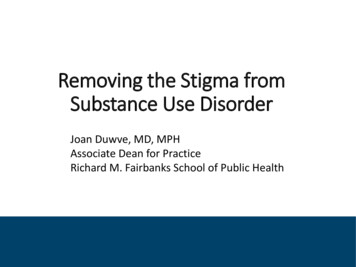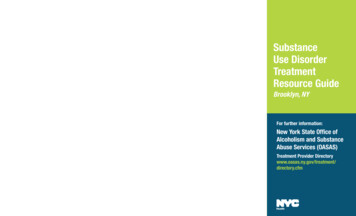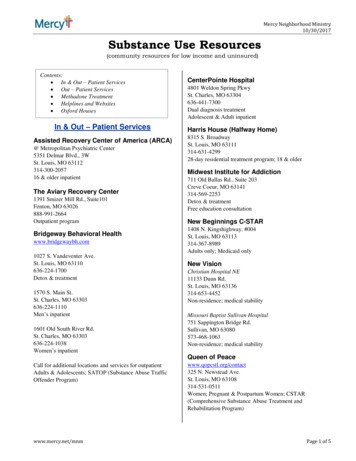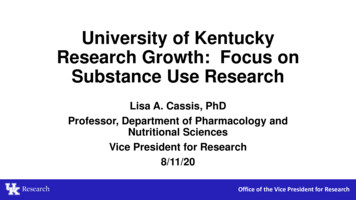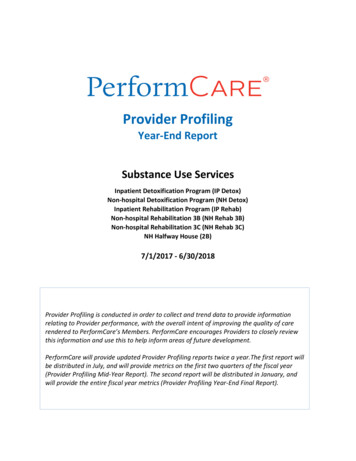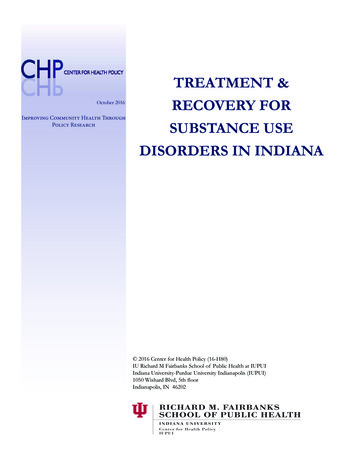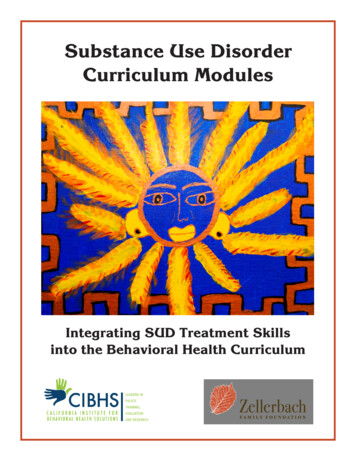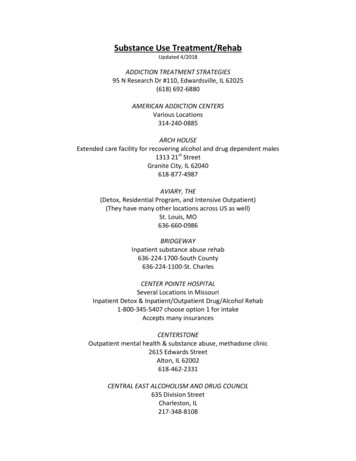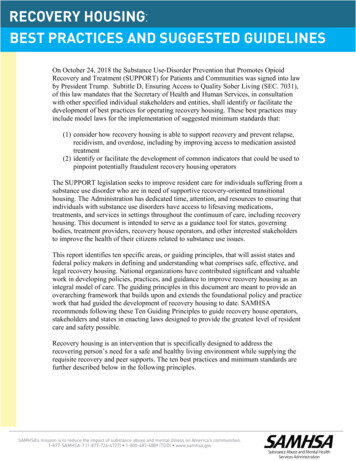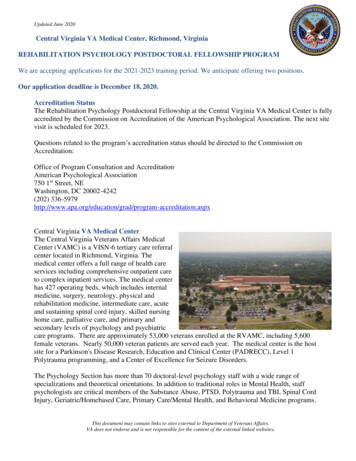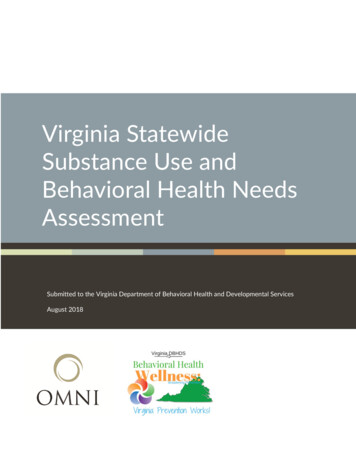
Transcription
Virginia StatewideSubstance Use andBehavioral Health NeedsAssessmentSubmitted to the Virginia Department of Behavioral Health and Developmental ServicesAugust 2018
Virginia StatewideSubstance Use andBehavioral Health NeedsAssessmentFor more information, please contact:Julia Simhai, MPHjsimhai@omni.org303-839-9422 ext. 137Katie Gelman, DrPH, MPHkgelman@omni.org303-839-9422 ext. 143For General Inquiries/QuestionsOMNI Institutep. 303-839-9422899 Logan Street, Suite 600f. 303-839-9420Denver, CO 80203www.omni.orgAcknowledgements: OMNI would like to thank: the Virginia Department of Behavioral Healthand Developmental Services, Office of Behavioral Health Wellness; members of the StateEpidemiology Outcomes Workgroup; and the local prevention staff from across theCommonwealth who shared their input and data throughout this needs assessment process.OMNI Contributors: Kait Markley, Cindy Vigil, Natalie Wheeler, Cheryl Winston
Table of ContentsExecutive Summary . 4Introduction . 4Key Findings. 4Introduction. 7Background . 7Methods and Data Sources . 7Substance Use and Behavioral Health in Virginia . 9Priority Areas . 12Areas to Watch . 15Risk and Protective Factors . 17Target Populations to Monitor. 19Community Input and Assessment. 21Current Prevention Efforts . 25Recommendations . 28Fund Priority Areas. 28Build Capacity . 29Lead Statewide Initiatives . 29References . 30Appendices . 37Appendix A. Needs Assessment Indicator List . 37Appendix B. Discussion Questions from April 2018 SEOW and DBHDS Meetings . 42Appendix C. SWOT Analysis Discussion Guide . 43Prepared by OMNI Institute3
Executive SummaryINTRODUCTIONIn the spring of 2018, OMNI Institute (OMNI) collaborated with the Virginia Department ofBehavioral Health and Developmental Services (DBHDS), Office of Behavioral Health Wellnessto examine the status and needs related to behavioral health and substance use in Virginia. Thereport represents the synthesis of more than seventeen national and local secondary datasources, including: health surveys; morbidity and mortality data; criminal justice and lawenforcement records; and population and social determinants of health statistics. In addition,OMNI collected primary data from over three dozen stakeholders through: a facilitateddiscussion of the data findings with the Statewide Epidemiology Outcomes Workgroup; adiscussion of priority areas with DBHDS staff; and a SWOT analysis with local prevention staff.KEY FINDINGSThis needs assessment revealed that the longstanding focus of prevention work on alcohol andtobacco remains a need in Virginia. As such, these two substances are designated priority areasalong with mental health and suicide. The selection of these areas as priorities is supported byhistorical and current prevalence and consequence data, as well as input from DBHDS, theVirginia Statewide Epidemiology Outcomes Workgroup, and Community Service Boards (CSBs).In recent years, DBHDS has shifted the prevention infrastructure in Virginia by emphasizingenvironmental prevention strategies and encouraging data-driven work. The recent completionof needs assessments and strategic planning by each CSB provided an excellent foundation foradvancing work towards these goals.Moving forward, DBHDS must balance its strategic direction and priority areas with emergingand topical public health issues that often shift attention from the longstanding preventionpriorities. With this needs assessment and the ensuing strategic planning, DBHDS will be wellpositioned to manage Virginia’s prevention priorities and leverage its resources for significantimpact and success.Prepared by OMNI Institute4
PRIORITY AREASPriority areas are substances or issues that have high prevalence, significant consequences, andrepresent public or behavioral health challenges across the Commonwealth.AlcoholAlcohol is the most commonly used substance in Virginia with 25% ofhigh schoolers and 56% of adults consuming alcohol in the past 30 days.In the past 10 years, the rate of alcohol-related deaths has increased.While Virginia has taken steps to address the ongoing issue of alcoholuse, it remains a critical public health issue that affects many Virginians.Tobacco andNicotineTwenty-six percent of Virginia adults and 16% of Virginia highschoolers have used some form of tobacco or nicotine in the pastmonth. While tobacco use has decreased in recent years, Virginia’s 30cent tax per pack of cigarettes is the second-lowest in the country. Inthe past several years, e-cigarettes and vaping have increased inpopularity, especially among youth (33% of high schoolers have tried anelectronic vapor product). These products present a new challenge tothe ongoing work of preventing tobacco use in Virginia.Mental Healthand SuicideMental health and suicide has been a longstanding issue in Virginia withapproximately 20% of Virginians experiencing a mental illness eachyear. More recently, Virginia has seen an increase in symptoms ofdepression and thoughts of suicide among youth, young adults, andadults. In addition to having high prevalence, the consequences of thesetrends are serious; suicide is the leading cause of death for individualswith mental health and substance use disorders.AREAS TO WATCHAreas to watch include substances or issues for which prevalence is relatively low, but trendingupward. Although the consequences of these issues may be severe, the current prevalence doeswarrant assigning priority status. Future data may indicate that these issues should be elevatedto priorities, and the data should be monitored accordingly.OpioidsMarijuanaCocaine andMethThe opioid crisis was declared a national public health emergency in2017. In Virginia, opioids are the leading cause of fatal overdoses.In Virginia, marijuana is more popular among youth than adults. Thereare concerns about how cultural and social norms will impact marijuanause as more states legalize marijuana.Rates of both cocaine and methamphetamine use remain low. However,their consequences, such as arrests, drug seizures, and fatal overdoses,are trending upward.Prepared by OMNI Institute5
COMMUNITY INPUT AND ASSESSMENTThirty-one prevention staff members from across the Commonwealth participated in SWOT(Strengths, Weaknesses, Opportunities, Threats) discussions, in which they identified severalstrengths and weaknesses of the prevention workforce, funding structure, and CSB operations.In addition, participants identified external opportunities that could facilitate prevention work inthe future, as well as threats that pose challenges to prevention work and may be areas toaddress in future g partnerships, coalition support, and passionate staff areessential to prevention work, and CSBs are already successfullyincorporating these items into their work in the priority areas.Both CSBs and DBHDS highlighted funding, staff resources, andworkforce skills as key internal weaknesses that hinder preventionwork in the priority areas.DBHDS’s emphasis on environmental strategies requires a switch fromdirect service to indirect, community-wide approaches. Many voiced thedesire for additional trainings, support, and resources to shift their workin this direction.Larger trends in the cultural and social acceptance of substance use,and the alignment of funding with these priority areas, are perceived asmajor external threats to prevention work.RECOMMENDATIONSAfter reviewing data trends, discussing with DBHDS and the State Epidemiology OutcomesWorkgroup, and receiving input from stakeholders across the Commonwealth, three key areasfor potential growth and action emerged:Fund PrioritiesStrategically impact priority areas by funding strategies and outcomesthat address appropriate risk and protective factors.Build CapacitySupport the prevention workforce across Virginia with training and peerlearning opportunities.Lead InitiativesLead efforts for statewide messaging, advocacy, collaboration, anddecision-making that facilitate effective prevention work across theCommonwealth.Prepared by OMNI Institute6
IntroductionBACKGROUNDThis report was prepared by OMNI Institute (OMNI), under the direction of the VirginiaDepartment of Behavioral Health and Developmental Services (DBHDS), Office of BehavioralHealth Wellness, to examine the status and needs related to behavioral health and substance usein Virginia. OMNI has partnered with DBHDS since 2014 to provide evaluation and capacitybuilding for the Substance Abuse Prevention Block Grant funding that is distributed to the 40Community Service Boards (CSBs) across the Commonwealth. OMNI has also served as atechnical assistance partner and evaluator for Virginia’s Partnerships for Success grant since2016, which funds nine communities to address prescription drug and heroin abuse.METHODS AND DATA SOURCESThis report represents the synthesis of primary and secondary data from a variety of sources.OMNI completed data gathering and preparation of this report from February – June 2018.Secondary DataDBHDSState EpidemiologyOutcomesWorkgroup (SEOW)Community ServiceBoards (CSBs)National sources(e.g., Centers forDisease Controland Prevention)Input on overallstrategic directionfor fundingstreamsFeedback onscope of needsassessmentInput on priorityareas and SWOTto address themVirginia agencies(e.g., Office of theChief MedicalExaminer)Discussion ofpriority areas atApril 2018meetingDiscussion ofpriority areas atApril 2018meetingExisting outcomesand strategies toaddress behavioralhealth andsubstance useData collection began with the compilation of a comprehensive list of indicators measuringtopics related to behavioral health and substance use from national sources, Virginia agencies,and the Virginia Social Indicator Dashboard1. OMNI shared this list of indicators with the StateEpidemiology Outcomes Workgroup (SEOW) to solicit feedback on the scope of the needsassessment, and ensure that all relevant topics would be considered in the data collectionprocess. A copy of the indicator list can be found in Appendix A. Needs Assessment Indicator Listand1The Virginia Social Indicator Dashboard is an online interactive resource that houses behavioral healthindicator data from agencies throughout Virginia. It can be used by stakeholders to examine trends acrossbehavioral health areas, as well as to assess areas of strength and need for specific geographic areas. eport Home.Prepared by OMNI Institute7
additional information about data sources included in the needs assessment can be found in theReferences section of the report.OMNI gathered data based on the final indicator list, including national, state, and localindicators, as well as trends over time. After reviewing these data, OMNI identified themes andkey findings to share with DBHDS and the SEOW. These findings were organized to examine therelative prevalence and trend data for seven substances (alcohol; tobacco; marijuana;prescription opioids; heroin and fentanyl; cocaine; and methamphetamines), mental health andsuicide, and risk and protective factors. In April 2018, OMNI held facilitated discussions withDBHDS and the SEOW. During these meetings, the data were presented and both groupsdiscussed what they viewed as the top behavioral health and substance use issues in theCommonwealth based on the data; what root causes were driving these issues; and whatresources are needed to address these issues. A copy of the data presentation can be found onthe Resources page of the Virginia Social Indicator Dashboard.2 A copy of the discussionquestions used can be found in Appendix B. The results of these discussions are included in thisreport and provided guidance for a second round of data collection within the identified priorityareas following the April meetings.Following the identification of priority areas, OMNI conducted an extensive SWOT (Strengths,Weaknesses, Opportunities, Threats) analysis with CSB staff and prevention directors doing onthe-ground prevention work across Virginia. These meetings were designed to gather theperspectives of the local staff on: the internal strengths and weaknesses of CSBs; their ability towork towards the priority areas; and the external threats and opportunities surrounding theirwork. Eight SWOT focus groups and discussions were conducted. The focus group topics weredivided by substance or behavioral health issue, allowing for two groups to focus on each of thethree priority areas – alcohol; tobacco and nicotine; and mental health and suicide. An additionaltwo discussions took place with staff from DBHDS. In total, 31 prevention staff participated inthe discussions. A copy of the SWOT discussion questions can be found in Appendix C.Finally, OMNI incorporated contextual information and data from the evaluation and technicalassistance work that OMNI does with CSBs and communities across Virginia. This includedaggregating information from technical assistance documents regarding strategies, resources,and outcomes in place through existing prevention funding.2Direct link to the data presentation Prepared by OMNI Institute8
Substance Use and BehavioralHealth in VirginiaDBHDS and the SEOW have identified priority areas to address in Virginia, along with areas towatch. Priority areas are substances or issues that have high prevalence, significantconsequences, and represent public or behavioral health challenges across the Commonwealth: Alcohol is the most commonly used substance in Virginia with 25% of high schoolers and56% of adults consuming alcohol in the past 30 days. In the past 10 years, the rate ofalcohol-related deaths has increased. While Virginia has taken steps to address the ongoingissue of alcohol use, it remains a critical public health issue that affects many Virginians. Tobacco and nicotine is currently used by 26% of Virginia adults and 16% of Virginia highschoolers. While tobacco use has decreased in recent years, Virginia’s 30 cent tax per packof cigarettes is the second-lowest in the country. In the past several years, e-cigarettes andvaping have increased in popularity, especially among youth (33% of high schoolers havetried an electronic vapor product). These products present a new challenge to the ongoingwork of preventing tobacco use in Virginia. Mental health and suicide has been a longstanding issue in Virginia with approximately 20%of Virginians experiencing a mental illness each year. More recently, Virginia has seen anincrease in symptoms of depression and thoughts of suicide among youth, young adults, andadults. In addition to having high prevalence, the consequences of these trends are serious;suicide is the leading cause of death for individuals with mental health and substance usedisorders.Areas to watch include substances or issues for which prevalence is relatively low, but trendingupward. Although the consequences of these issues may be severe, the current prevalence doeswarrant assigning priority status. Future data may indicate that these issues should be elevatedto priorities, and the data should be monitored accordingly: Opioids: The opioid crisis was declared a national public health emergency in 2017. InVirginia, opioids are the leading cause of fatal overdoses. Marijuana: In Virginia, marijuana is more popular among youth than adults. There areconcerns about how cultural and social norms will impact marijuana use as more stateslegalize marijuana.Prepared by OMNI Institute9
Cocaine and Methamphetamines: Rates of both cocaine and methamphetamine use remainlow. However, their consequences, such as arrests, drug seizures, and fatal overdoses, aretrending upward.DBHDS and the SEOW recognize that these priorities do not cover the full scope of challengesin the areas of substance use and behavioral health in Virginia. However, these represent currentissues of note across the Commonwealth, and offer a data-driven assessment of existingprevention priorities.The following pages include selected data for each of the priority areas and areas to watch.These data are not comprehensive pictures of each substance or mental health issue in Virginia,but do provide insight into the prevalence, consequences, and disparities that are most pressingin each area.Data for selected risk and protective factors are also provided. This information is integral tounderstanding and influencing substance use and behavioral health, and provides importantcontext for the identified priority areas. Further, research indicates that targeting shared risk andprotective factors can yield significant gains in prevention across several inter-related issueareas, including substance abuse and mental health.Additional information about the priority areas, areas to watch, and risk and protective factorsdata can be found in the References section at the end of the report.Prepared by OMNI Institute10
Prevalence of mental health issues and substance use are higher for priority areasthan areas to watch among both youth and adults.Across all substances, alcohol and tobacco use in the past month are most prevalent,even when compared with other substance use in the past year or in a person’slifetime.Adu
OMNI Institute 899 Logan Street, Suite 600 Denver, CO 80203 www.omni.org . Prepared by OMNI Institute 3 Table of ontents . Prepared by OMNI Institute 4 Executive Summary INTRODUCTION In the spring of 2018, OMNI Institute (OM

